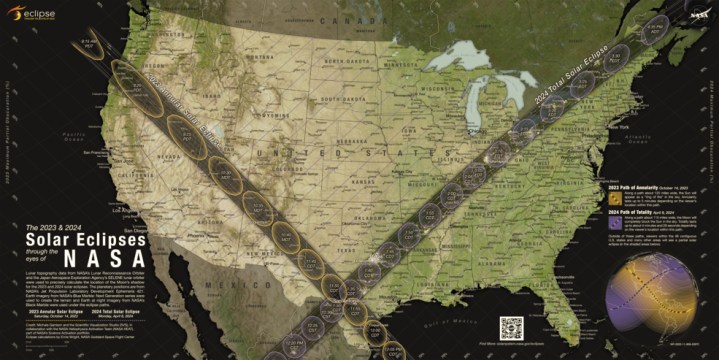Some of the most fascinating astronomical events to see from Earth are solar eclipses, when the moon passes between the Earth and the sun and blocks out some or all of the sun’s light. The resulting darkness during daytime is fascinating and can lead to some stunning views — though, for safety reasons, you should never look directly at the sun and should use a tool like a pinhole camera to observe eclipses instead.
However, these eclipses happen on a rather complex schedule related to the orbit of the moon, so exactly when and where to see an eclipse can be hard to track. To help with this, NASA has created a map of the U.S. showing when and where you can see a solar eclipse in 2023 and 2024.

The full map shows the two upcoming annual solar eclipses and the time you’ll need to look out for them based on your location and time zone. The regions that will experience the solar eclipses are long, narrow bands because of the path that the moon’s shadow leaves on Earth. These are the regions where the sun will appear to be fully eclipsed, though those outside these regions will be able to see partial eclipses — where the moon blocks out part of the sun’s disk, but not the entire face.
Lucky skywatchers in San Antonio, Texas, will be able to see both the 2023 and 2024 eclipses, which will occur on October 14, 2023, and April 8, 2024.
The map was created by Michala Garrison, a member of the Scientific Visualization Studio (SVS) at NASA’s Goddard Space Flight Center, to help inform people about eclipses so they don’t miss opportunities to catch these exciting events.
“In 2017, I was in Maryland, so I still got to see a little bit, because I was in a partial eclipse,” Garrison said in a statement. “But I didn’t really know any of this back then. This does make me want to go to, say, Albuquerque [New Mexico] in 2023. And then, in 2024, to go more south.”
Creating the map so that it was both informative and attractive took many revisions, she said. “It took a lot of trial and error. I wanted it to be useful to the reader, but not overwhelming – and still be a pretty product to look at to catch people’s eye.”
Editors’ Recommendations
Services Marketplace – Listings, Bookings & Reviews